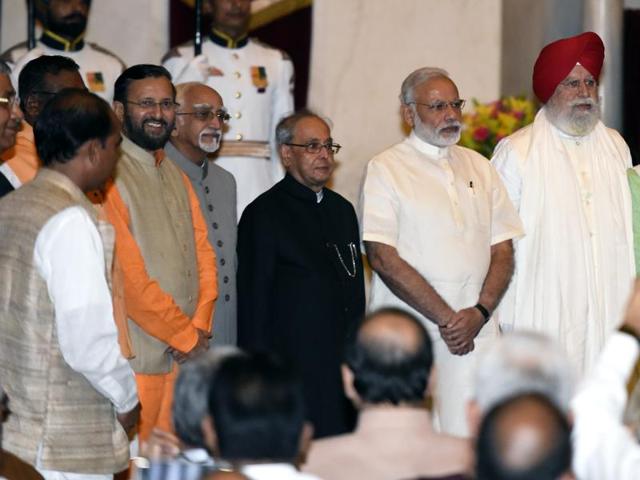Modi’s expanded cabinet exposes BJP’s lack of bench strength
If below-par performance of his colleagues was what prompted the Prime Minister to go for a Cabinet revamp on Tuesday, then the expanded Team Modi only exposes a lack of bench strength in the ruling Bharatiya Janata Party (BJP).
If below-par performance of his colleagues was what prompted the Prime Minister to go for a cabinet revamp on Tuesday, then the expanded Team Modi only exposes a lack of bench strength in the ruling Bharatiya Janata Party (BJP).

True, Narendra Modi entrusted some junior ministers with independent charge of portfolios and brought in a river conservationist with strong RSS links, Anil Madhav Dave, as environment minister but the rest of the rejig underlines minimal options.
For instance, Ravi Shankar Prasad has now been given back the law ministry, 19 months after he was shifted out of it. An accomplished lawyer, he had lost the portfolio in November 2014, barely six months after assuming charge. Today, Prasad also holds charge of Electronics & IT.
Choudhury Birendra Singh has been removed as rural development minister ostensibly for his uninspiring performance. He will now take care of steel, a sector which is reeling under a crisis. Narendra Singh Tomar, who had a rather forgettable tenure as steel minister, has been given charge of the crucial rural development ministry.
The biggest surprise, though, was Smriti Irani’s removal from the human resource development ministry, which has now been entrusted with Prakash Javadekar. Many conspiracy theories float about as reasons. If her unsatisfactory performance as HRD minister was one, then her shift to the ministry of textiles is curious given the government’s thrust on the sector. It recently announced a special Rs 6,000-crore package for the textile and apparel sector, aiming to create one crore jobs in the next three years.
Irani was in a jovial mood on Tuesday forenoon after the swearing-in at the Rashtrapati Bhavan, often bursting into laughter while exchanging pleasantries with reporters. In contrast, some junior ministers found their hopes for promotion dashed, and were huddled in a corner outside the Darbar Hall. One of them even went up to Javadekar to know about the “formula” of his promotion to cabinet rank.
Read| ‘Kuchh toh log kahenge’: Smriti Irani on reports of her role in UP elections
Modi’s intent was clear: thumbs down to headline-hunters and those with a penchant for controversies. It is another matter that the NDA government had, on the occasion of its second anniversary in May, made tall claims of significant achievements in every sector.
If loud disputes were apparently what triggered Irani’s exit from the HRD, then her successor had an equally issues-riddled tenure as environment minister. Questions were raised about Javadekar’s almost 100 per cent clearance of projects in forest areas.
On Wednesday, the HRD minister spoke of his credentials in the new role, recalling his participation in the 1970s students’ movement led by socialist leader Jayaprakash Narayan.
Evidently, politics, and not governance, was the primary consideration behind the selection of the new ministers. It was BJP president Amit Shah, and not the PM, who called up the 19 lucky MPs on Tuesday. Even during the UPA regime, which was criticised for its “dual power centre”, it was PM Manmohan Singh who made the telephone call, and not always in the presence of the Congress president.
Among Modi’s new ministers, five are Dalits and two tribals--a clear indication of the BJP’s outreach to these communities. With the addition of three ministers from election-bound Uttar Pradesh, the state’s representation in the union council of ministers has gone up to 15. Uttarakhand, another state going to polls early next year, also found representation in the ministry with the induction of Dalit leader Ajay Tamta.
On Monday evening, spin doctors of the ruling dispensation circulated educational and professional backgrounds of to-be-inducted ministers to project that doers and performers were being brought in. The claim, however, sounded over-the-top in the backdrop of controversies over the educational qualifications of ministers such as Smriti Irani who was holding HRD.
Besides, despite clear allocation of work to junior ministers in the Modi government, there are very few Cabinet ministers like Arun Jaitley and Suresh Prabhu who involve their deputies in the decision-making process. Minister of state for urban development Babul Supriyo, for instance, is often asked by his boss, Venkaiah Naidu, to sing at official meetings. Little is known about the official work of the Bengali musician of ‘Kaho Na Pyar Hai’ fame.
The contributions of many other junior ministers have been paltry, at best. But they, too, may wonder about Javadelkar’s “formula”.
Read| Everything you need to know about Modi’s cabinet reshuffle
Read| With cabinet expansion, Modi performs a balancing act in poll-bound UP



